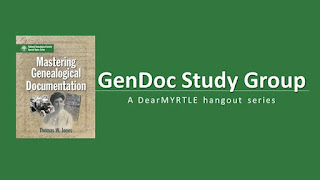Mastering Genealogical Documentation Study Group
Chapter One: The Purpose and Nature of Genealogical
Documentation
Marceline Beem
Reference:
Jones, Thomas W. "The Purpose and Nature of Genealogical Documentation." In Mastering Genealogical Documentation, 1-10. Arlington, VA: National Genealogical Society, 2017.
I can't remember a time in my research where documenting my sources wasn't important to me. Some of my earliest readings in compiled genealogies had me scratching my head and asking "How did he know that?" These books were, of course, older books that had no bibliography or works cited sections.
Although I understood the importance of citing my sources, I wasn't always consistent with that part of the research process, probably because I didn't understand the importance of writing my conclusions - outside of putting them into my Legacy file, that is. Now that I'm writing up my research notes and conclusions as I go, having a better understanding of how to craft a citation without relying exclusively on software templates or having to pick up Evidence Explained is one of the areas I'd like to grow in, and one reason I'm excited about being part of this study group.
One of the points that Dr. Jones makes in the first chapter is that citations formats found in guides such as Evidence Explained are great starting places, but sometimes adjustments need to be made, and that's okay.1 One example of this from my own research came in crafting a citation for the 1850 census listing of my 3rd great-grandfather, James Baldwin, who was living in Duval County, Florida. Here is an image of the census:
 |
| James Baldwin family, 1850, Duval County, Florida |
Usually a census citation would include the dwelling number and family number, but on this page, those columns are hard to read. Using enhancement tools at both Ancestry.com and FamilySearch did not help. To overcome that, I use the line number and include a notation for the reason for that when I cite this census record.2 Making this substitution, the basic citation now looks like this:
This is a simple example of having flexibility in creating citations, but hopefully it helps us start to think through what we are citing, and go beyond using the style guides as "models and templates to slavishly copy."3
___________________________________________
1. Jones, Thomas W. Mastering Genealogical Documentation (Arlington, VA: National Genealogical Society, 2017), 5.
2. See the first footnote on my blog post "GPS Study Group Week 2: Where was James Baldwin born?," 40th & Plum (https://40th-and-plum.blogspot.com/2017/01/gps-study-group-week-2-where-was-james.html), published January 22, 2017.
3. Jones, Mastering Genealogical Documentation, 6.
| 1850 U.S. census, Duval County, Florida, population schedule, Thomasville District, page 118 (stamped), line 6, James Baldwin; digital image, FamilySearch.org (http://www.familysearch.org : accessed 24 Sep 2016); citing NARA microfilm publication M432. (The page is hard to read because of faded ink, even when using viewing aids at Ancestry and FamilySearch. In the citation, the line item is used because the dwelling and family numbers are partially illegible.) |
___________________________________________
1. Jones, Thomas W. Mastering Genealogical Documentation (Arlington, VA: National Genealogical Society, 2017), 5.
2. See the first footnote on my blog post "GPS Study Group Week 2: Where was James Baldwin born?," 40th & Plum (https://40th-and-plum.blogspot.com/2017/01/gps-study-group-week-2-where-was-james.html), published January 22, 2017.
3. Jones, Mastering Genealogical Documentation, 6.


I learned so much from Dr. Jones. His explanation of crafting citations was such a great foundation for doing gen research. When you read his citations in articles, they are really fascinating.
ReplyDeleteThanks for sharing your experience and feedback as you went through Dear Myrtle's study group! I am just starting to go through the book myself and wanted someone at least virtually to go through this with me.
ReplyDelete